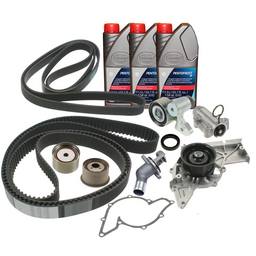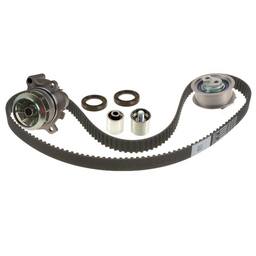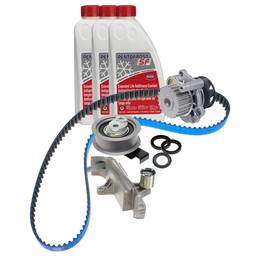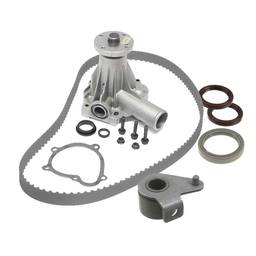Despite being around for over a century now, cars haven’t changed much at their core. The internal combustion engine still burns fuel to create propulsion, just like it did in the early years of automotive design. Although far more sophisticated, modern engines, just like ones before them, rely on timing to keep everything working smoothly. That’s why regular timing belt replacement is about as high as it can be on the automotive maintenance totem pole.
Organized Chaos
An average engine is a chaotic place. Aside from the fact that there are thousands of controlled explosions happening in each cylinder per minute, there’s also a wide range of mechanical parts that keep those explosions in check.
You’ve got valves opening to let in air, injectors shooting fuel into each cylinder, exhaust valves evacuating gasses from the engine, water pump working around the clock to keep the whole thing at an optimal temperature, and much, much more.
Needless to say, timing is everything when you’re dealing with such violent mechanical environments. There are several ways to maintain timing in an engine – using a belt, a timing chain, or sprockets. Despite being the latest option in use, timing belts are slowly proving to be the optimal choice for keeping all parts of an engine in time.

What Exactly is a Timing Belt?
A timing belt is a composite rubber belt that is used to keep the engine in sync and power all the main components of the engine. It’s a key component, but also one that requires regular maintenance. The way a timing belt works is simple.
Every engine has a timing side where all the sprockets and pulleys are. All of these are geared except for the tensioner pulleys whose main job is to provide tension to this belt system. The belt itself has teeth that sink into the sprocket gears, thus providing enough force to turn everything that’s linked into this system.
A timing belt shouldn’t be confused with the accessory belt. The latter is smooth and serves an entirely different purpose. Namely, the accessory belt is there to power the power steering pump, your HVAC compressor, and other accessories on the engine.
When Should You Replace a Timing Belt?
Every vehicle whose engine is timed using a timing belt has two maintenance cycles. One is the more frequent maintenance cycle where you’re replacing the engine oil and the necessary filters. The other is the timing belt replacement cycle, which comes around every 60,000 to 80,000 miles, sometimes less, sometimes more depending on the engine.
Knowing how many miles you can go between a timing belt change is essential for keeping the engine working smoothly. You can source this information from your vehicle’s user manual. It’s highly recommended that you stick to whatever the manufacturer prescribes.
However, a timing belt can wear out prematurely. This can happen due to low-quality replacement belts being used, abnormal use, or other reasons. Whatever the case may be, you can generally prevent any serious damage by simply checking the belt state from time to time.
What you’re looking for are signs of stress and deterioration of materials. Cracks, missing teeth, and similar symptoms are a good indicator that your automobile’s belt requires a replacement.

What Happens if You Don’t Replace the Timing Belt?
Failing to replace a timing belt can lead to catastrophic consequences down the line. Some belts will push past their marked maximum mileage. However, the moment you cross that line, you’re in dangerous territory.
Remember how timing belts keep everything synced up within the engine? Well, if you leave a belt in there for too long, it could snap. Once that happens, you’ll see pistons shaking hands with valves, and then you’re in real trouble.
A snapped timing belt can cause massive damage to the engine. So much so that you’ll most likely have to rebuild the whole thing to salvage the car. Oftentimes the rebuild job is simply not worth the effort if the car in question is of a more modern variety.
How Complicated Is It to Replace a Timing Belt?
Here at eEuroparts.com, we appreciate the DIY community. In fact, our entire policy is geared towards those who aren’t afraid to get their hands dirty at home. That being said, doing a timing belt replacement could potentially be above many enthusiast’s pay grades.
Once again, this depends on the car. Some engines are very easy to work on with plenty of room to reach everything you need to reach. Others? Not so much. Cramped engine bays are the bane of every DIYer’s existence and for some reason, more and more manufacturers are adopting this approach.
The bottom line is this. Sometimes you can replace the belt by simply lining up all the sprockets so that they’re timed correctly, then releasing the tensioner and replacing the belt. Other times, it’s different. Some engines require you to tear down half of the engine just to get to the belt. Then you might need a specialized tool to lock the engine while you’re replacing the belt. It all depends on your car’s make and model.
Is Timing Belt Replacement Expensive?
The answer to this question ties into the previous one. The replacement process itself can cost very little depending on how user-friendly your engine bay is as well as who will do the job. If you’re doing it yourself, you can get the replacement done on the cheap.
The alternative is a cluttered engine bay and the need to take the vehicle to your favorite technician. In that case, you could be looking at a pretty expensive bill.
How to Choose the Right Belt?
Timing belts, just like any other part of the car, are made by the various manufacturer. Some are good, some not so much. The key to selecting the right belt is to know which model you’re looking for and to stick to proven brands and OEM parts. Avoid cheap belts, no matter how tempting the price might be. Going with one of those is a great way to say goodbye to your valves.
Cheap belts are often made from subpar materials. The rubber on a cheap set will lose its flexibility far sooner compared to a quality timing belt. As a result, going with a cheap belt is just setting yourself up for another repair, not too far in the future.

Finding a Belt for your Vehicle
To find which timing belt matches your vehicle, simply head over to our online store and input your car’s data into our search tool. Once our system crunches the information, you’ll get a list of parts that match your car.
Another way to find the right belt is to use your VIN. We’ve built a VIN tool that will show you vehicle parts that match your specific VIN. If you end up having any questions regarding our offer or any specific product, feel free to get in touch with us. You can reach us via email or by phone. Our customer support reps will be more than happy to answer any questions you might have.







